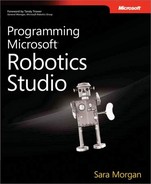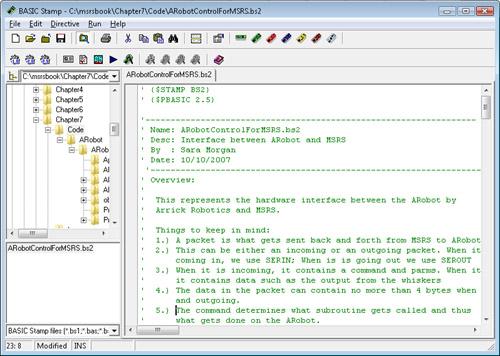The onboard interface acts as a software driver. It is used to interpret commands sent to a remotely connected robot from an MSRS service. What constitutes the interface depends on the type of robot you are interfacing with. For example, the ARobot uses a BS2 as the coprocessor. The BS2 has only 32 bytes of memory, and only 26 of those are available to a downloaded program. Obviously, neither MSRS nor the .NET Framework is able to execute on this coprocessor. For this reason, we need software that can execute on the robot and pass information back and forth to a remote development machine capable of running MSRS.
The software we need is a BASIC program, which can be written and downloaded to the ARobot using a Basic Stamp Editor, such as the one available as a free download from the Parallax Web site (www.parallax.com/html_pages/downloads/software/software_basic_stamp.asp). The BASIC interface program is responsible for accepting commands from the MSRS services and returning information concerning the whisker sensors. The first thing the interface program does is make the speaker beep twice and turn on the green light-emitting diode (LED) light. This signals that the ARobot is ready to start accepting commands from MSRS. The first portion of this code should look like the following:
Start: ' Performs 2 short beeps when the robot starts up FREQOUT SPEAKER,150,2000 PAUSE 10 FREQOUT SPEAKER,150,2000 LOW SPEAKER 'turn off speaker. LOW GREENLED 'turn on the Green LED light
The next thing this and any interface program should do is begin a loop. Within the loop should be code that accepts input from the serial port and performs commands on the robot based on the data it receives. The loop should also contain code that returns data from sensors and actuators. For the interface program used by the ARobot, the code looks like the following:
Main:
'-----------------------------------------------------------------
' Main routine - this loop should run continuously
'-----------------------------------------------------------------
DO
' Get the next command by using the SERIN command
' to receive in the serial data sent in a packet
' The packet should contain no more than 4 bytes
' after the MSRS header
SERIN Console, CMD_BAUD,300, NoCmd, [WAIT ("MSRS"), STR inBuffer 4]
' Process the incoming command by looking up what subroutine
' it is calling
LOOKDOWN inBuffer(0), = [DRIVE_ROBOT, ON_RED_LED, OFF_RED_LED, ON_GREEN_LED,
OFF_GREEN_LED, SET_SPEAKER], routine
ON routine GOSUB DriveRobot, OnRedLED, OffRedLED, OnGreenLED, OffGreenLED, SetSpeaker
PAUSE 100
NoCmd: ' We want to always return whisker values
outBuffer(0) = LEFT_WHISKER 'Left whisker
outBuffer(1) = RIGHT_WHISKER 'Right Whisker
outBuffer(2) = 0
SEROUT Console, CMD_BAUD, ["ROB", STR outBuffer 4]
LOOPBased on data it receives from MSRS, the interface program executes a subroutine. This subroutine contains specific functions such as driving the robot, setting the speaker, and turning on and off the LED lights. For example, the DriveRobot subroutine accepts parameters representing the distance, direction, and speed from the input buffer. Based on the values it receives, it sends commands to the BS2 coprocessor using SEROUT commands. The code for the DriveRobot subroutine is as follows:
DriveRobot:
'First, get the input variables
tDistance = inBuffer(1)
tDirection = inBuffer(2)
tSpeed = inBuffer(3)
SELECT tDirection
CASE "S" 'Stop the robot
tmp1 = "0"
tSteer(0) = "0"
tSteer(1) = "0"
CASE "B" 'Go backwards
tmp1 = "0"
tSteer(0) = "8"
tSteer(1) = "0"
CASE "F" 'Go forwards
tmp1 = "1"
tSteer(0) = "8"
tSteer(1) = "0"
CASE "R" 'Go right
tmp1 = "1"
tSteer(0) = "0"
tSteer(1) = "1"
CASE "L" 'Go left
tmp1 = "1"
tSteer(0) = "F"
tSteer(1) = "F"
ENDSELECT
'Send commands to the CoProcessor and get a response
SEROUT COPROC, NET_BAUD, ["!1R1"] 'Send RC command to coprocessor.
SEROUT COPROC, NET_BAUD, [tSteer(0)] 'Steer command 1
SEROUT COPROC, NET_BAUD, [tSteer(1)] 'Steer command 2
SERIN COPROC, NET_BAUD, [tResponse] 'Get a response
PAUSE 300 'Pause 300 ms
SEROUT COPROC, NET_BAUD, ["!1M1"] 'Starting part of command to co.
SEROUT COPROC, NET_BAUD, [tmp1] 'Set the direction 1=forward 0=backward
SEROUT COPROC, NET_BAUD, [HEX1 tSpeed] 'Set the speed
IF tDistance = 0 AND tDirection = "S" THEN
SEROUT COPROC, NET_BAUD, ["0001"] 'Turn the motor off
ELSEIF tDistance = 0 AND tDirection <> "S" THEN
SEROUT COPROC, NET_BAUD, ["FFFF"] 'Set Distance for forever
ELSE
SEROUT COPROC, NET_BAUD, [HEX4 tDistance] 'Set Distance set number of inches
ENDIF
SERIN COPROC, NET_BAUD, [tResponse] 'Get a response
PAUSE 100 'Pause 100 ms
RETURNNote
You may be a bit confused when you notice that the code is sending serial commands to another processor. This is because the ARobot has two controllers. One is the main controller board, and this is where you send the serial commands from the MSRS service. The main controller board is used to control the robot’s speaker and LED lights. Additionally, there is a BS2 controller, which is used to power the RC steering and gear motors.
The remaining subroutines are used to turn on and off the LED lights and set the speaker using duration and frequency parameters passed into the input buffer. The code for these subroutines is as follows:
OnRedLED: LOW REDLED 'turn on the Red LED light RETURN OffRedLED: HIGH REDLED 'turn off the Red LED light RETURN OnGreenLED: LOW GREENLED 'turn on the Green LED light RETURN OffGreenLED: HIGH GREENLED 'turn off the Green LED light RETURN SetSpeaker: tDuration = inBuffer(1) 'Get time in ms that speaker should sound out tFrequency = inBuffer(2) 'get the frequency FREQOUT SPEAKER, tDuration * 50, tFrequency * 50 'Set the tone LOW SPEAKER 'turn off the speaker RETURN
The code for the onboard interface program is available on this book’s companion Web site. The file named ARobotControlForMSRS.bs2 should be loaded into the Basic Stamp Editor and executed by clicking Run from the program menu bar (see Figure 7-3). If the download was successful, you should hear two short beeps, and the green LED light will turn on.

